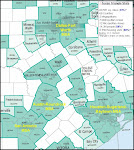Just press CTRL+P for a new home
Discovery News reported recently on an outfit in the U.K. that's hoping to build a system that will "print" an entire room of a house.
The process uses techniques from the rapid prototyping industry, which allows engineers and designers to convert CAD drawings into 3D plastic models.
A leader in rapid prototyping is Stratasys, based in the Minneapolis suburb of Eden Prairie. (I wrote an article about the company back in 2005.) Publicly traded, Stratasys has been in rapid prototyping for many years. The founder & CEO Scott Cramp developed a prototype for his first machine working in his spare time from home.
Ultimately, Cramp sees rapid prototyping evolving into rapid manufacturing. To that end, Stratasys began working with NASA to put a machine on the International Space Station that can print out replacement parts in supertough polycarbonate plastics or other plastic materials. Like in Star Trek, NASA will be able to "beam up" plans for the required parts, that will then be produced in situ.
Back then rapid manufacturing was already happening. Just down the road from Stratasys, in fact. Eden Prairie-based company, MTS, had a subsidiary called AeroMet Corp. that used Stratasys software in a process it calls laser additive manufacturing. Using a laser and powdered metal, AeroMet can build structures up to 12 feet long that can be aerospace grade quality. (MTS closed down the operation in 2005, however.)
Stratasys is now in the rapid manufacturing business through a license technology that produces metal parts. The company calls the process "direct digital manufacturing."
So given all that development, it doesn't seem crazy that this U.K. firm is looking to use mineral-based construction materials to build a room one layer at a time.
The article reports: "The machine will either squeeze out the moist material like toothpaste from a tube or it work like a large ink-jet printer head to place drops of the material in the precise location. The material will be designed to harden in the air and will not require a laser to fuse the layers together.
Such precision will allow designers to incorporate elements into walls that would otherwise have to be built in separately. For example, the walls could have holes to accommodate doors and windows. They could be built with a honeycomb structure for insulation. Or they could contain hollow sections that serve as conduits for piping or electrical wires."
It opens up new ways of thinking about home construction, which could impact tomorrow's suburbia. GEO
Why Do Democrats Support Transit?
-
Some good excerpts, bold highlights mine: “What drives Republican
opposition to transit?” asks Governing magazine. I’ve often wondered the
reverse of this...
1 week ago

0 Comments:
Post a Comment